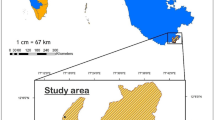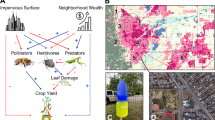Abstract
Invasive plants are a growing concern worldwide for conservation of native habitats. In endangered wet meadow habitat in the Upper Midwestern United States, reed canary grass (Phalaris arundinacea) is a recognized problem and its prevalence is more widespread than the better-known invasive wetland plant purple loosestrife (Lythrum salicaria). Although resource managers are concerned about the effect of reed canary grass on birds, this is the first study to report how common wet meadow birds use habitat in relation to reed canary grass cover and dominance. We examined three response variables: territory placement, size of territories, and numbers of territories per plot in relation to cover of reed canary grass. Territory locations for Sedge Wren (Cistothorus platensis) and Song Sparrow (Melospiza melodid) were positively associated with reed canary grass cover, while those for Common Yellowthroat (Geothlypis trichas) were not. Only Swamp Sparrow (M. georgiana) territory locations were negatively associated with reed canary grass cover and dominance (which indicated a tendency to place territories where there was no reed canary grass or where many plant species occurred with reed canary grass). Swamp Sparrow territories were positively associated with vegetation height density and litter depth. Common Yellowthroat territories were positively associated with vegetation height density and shrub cover. Song Sparrow territories were negatively associated with litter depth. Reed canary grass cover within territories was not associated with territory size for any of these four bird species. Territory density per plot was not associated with average reed canary grass cover of plots for all four species. Sedge Wrens and Song Sparrows may not respond negatively to reed canary grass because this grass is native to wet meadows of North America, and in the study area it merely replaces other tall lush plants. Avoidance of reed canary grass by Swamp Sparrows may be mediated through their preference for wet areas where reed canary grass typically does not dominate.
Similar content being viewed by others
Literature Cited
Akaike, H. 1973. Information theory and an extension of the maximum likelihood principle. p. 267–81. In B. N. Petrov and F. Csáki (eds.) 2nd International Symposium on Information Theory. Akademiai Kiadó, Budapest, Hungary.
Barnes, W. J. 1999. The rapid growth of a population of reed canarygrass (Phalaris arundinacea L.) and its impact on some riverbottom herbs. Journal of the Torrey Botanical Society 126: 133–38.
Benoit, L. K. and R. A. Askins. 1999. Impact of the spread of Phragmites on the distribution of birds in Connecticut tidal marshes. Wetlands 19: 194–208.
Benson, T. J. 2003. Breeding bird, plant, and arthropod responses to restoration and management of riparian conservation easements in the Iowa River corridor, east-central Iowa. M.S. Thesis. Iowa State University, Ames, IA, USA.
Bernthal, T. W. and K. G. Willis. 2004. Using Landsat 7 imagery to map invasive reed canary grass (Phalaris arundinacea): a landscape level wetland monitoring methodology. Final Report to U.S. EPA-Region V, Wetland Grant #CD975115-01-0
Bibby, C. J., N. D. Burgess, and D. A. Hill. 1997. Bird Census Techniques. Academic Press, London, UK.
Bonham-Carter, G. F. 1996. Geographic Information System for Geoscientist — Modeling with GIS. Elsevier, Tarrytown, NY, USA.
Bryan, G. G. and L. B. Best. 1991. Bird abundance and species richness in grassed waterways in Iowa row-crop fields. American Midland Naturalist 126: 90–102.
Burnham, K. P. and D. R. Anderson. 2002. Model Selection and Multimodel Inference: A Practical Information-Theoretic Approach, second edition. Springer-Verlag, New York, NY, USA.
Camp, M. and L. B. Best. 1994. Nest density and nesting success of birds in roadsides adjacent to rowcrop fields. American Midland Naturalist 131: 347–58.
Cochrane, T. S. and H. H. Iltis. 2000. Atlas of Wisconsin Prairie and Savanna Flora. Wisconsin Department of Natural Resources Technical Bulletin 191, Madison, WI, USA.
Curtis, J. T. 1959. The Vegetation of Wisconsin. University of Wisconsin Press, Madison, WI, USA.
Freemark, K. E. and H. G. Merriam. 1986. Importance of area and habitat heterogeneity to bird assemblages in temperate forest fragments. Biological Conservation 36: 115–41.
Fretwell, S. D. 1972. Populations in a Seasonal Environment. Princeton University Press, Princeton, NJ, USA.
Fretwell, S. D. and H. L. Lucas, Jr. 1970. On territorial behavior and other factors influencing habitat distribution in birds: I. Theoretical development. Animal Behavior 19: 16–36.
Galatowitsch, S. M., N. O. Anderson, and P. D. Ascher. 1999. Invasiveness in wetland plants in temperate North America. Wetlands 19: 733–55.
Green, E. K. and S. M. Galatowitsch. 2002. Effects of Phalaris arundinacea and nitrate-N addition on the establishment of wetland plant communities. Journal of Applied Ecology 39: 134–44.
Greenberg, R. 1988. Water as a habitat cue for breeding Swamp and Song Sparrows. Condor 90: 420–27.
Groshek, A. 2000. Grappling with the green giant. Wisconsin Natural Resources 24(4): 12–16.
Guzy, M. J. and G. Ritchison. 1999. Common Yellowthroat (Geothlypis trichas). In A. Poole and F. Gills (eds.) The Birds of North America, No. 448. The Birds of North America, Inc., Philadelphia, PA, USA.
Herkert, J. R., D. E. Kroodsma, and J. P. Gibbs. 2001. Sedge Wren (Cistothorus platensis). In A. Poole and F. Gill (eds.) The Birds of North America, No. 582. The Birds of North America, Inc., Philadelphia, PA, USA.
Hoffman, R. M. and D. Sample. 1988. Birds of wet-mesic and wet prairies in Wisconsin. Passenger Pigeon 50: 143–52.
Hoffman, R. M. and D. Sample. 1995. Grassland communities. p. 118–29. In Wisconsin’s Biodiversity as a Management Issue. A report to Department of Natural Resource Managers (May 1995), prepared by J. Addis, E. Eckstein, A. Forbes, D Gebken, R. Henderson, J. Kotar, B. Les, P. Matthiae, W. McCown, S. Miller, B. Moss, D. Sample, M. Staggs, and K. Visser, Madison, WI, USA.
Johnston, K., J. M. Ver Hoef, K. Krivoruchko, and N. Lucas. 2001. Using ArcGIS Geostatistical Analyst. ESRI Press, Redlands, CA, USA.
Knutson, M. K., G. Butcher, J. Fitzgerald, and J. Shieldcastle. 2001. Partners in Flight Bird Conservation Plan for the Upper Great Lakes Plain (Physiographic Area 16). USGS Upper Midwest Environmental Sciences Center in cooperation with Partners in Flight. La Crosse, WI, USA.
Krüger, O. and J. Lindström. 2001. Habitat heterogeneity affects population growth in goshawk Accipiter gentiles. Journal of Animal Ecology 70: 173–81.
Lavoie, C., C. Dufresne, and F. Delisle. 2005. The spread of reed canarygrass (Phalaris arundinacea) in Quebec: a spatio-temporal perspective. Ecoscience 12: 366–75.
Liang, K. Y. and S. L. Zeger. 1986. Longitudinal data analysis using generalized linear models. Biometrika 73: 13–22.
Lloyd, J. D. and T. E. Martin. 2005. Reproductive success of Chestnut-collared Longspurs in native and exotic grassland. Condor 107: 363–74.
Marten, G. C. 1985. Reed canary grass. p. 207–16. In M. E. Heath (ed.) Forages, the Science of Grassland Agriculture. Iowa State University Press, Ames, IA, USA.
Maurer, D. A., R. Lindig-Cisneros, J. Werner, S. Kercher, R. Miller, and J. B. Zedler. 2003. The replacement of wetland vegetation by reed canarygrass (Phalaris arundinacea). Ecological Restoration 21: 116–19.
Meier, M. S. 2004. Effects of reed canary grass (Phalaris arundinacea) on terrestrial arthropod biomass, abundance and diversity in Upper Midwestern riparian wet meadows. M.A. Thesis. University of Wisconsin-La Crosse, La Crosse, WI, USA.
Merigliano, M. F. and P. Lesica. 1998. The native status of Reed Canarygrass (Phalaris arundinacea L.) in the inland Northwest, USA. Natural Areas Journal 18: 223–30.
Minnesota County Biological Survey. 1996a. Natural communities and rare species of Winona County, Minnesota. Minnes sota County Biological Survey Map Series number 11. Minneseota Department of Natural Resources, St. Paul, MN, USA.
Minnesota County Biological Survey. 1996b. Natural communities and rare species of Winona County, Minnesota. Minnesota County Biological Survey Map Series number 11. Minneseota Department of Natural Resources, St. Paul, MN, USA.
Moré, J. J. and D. C. Sorensen. 1983. Computing a trust-region step. SIAM Journal on Scientific and Statistical Computing 4: 553–72.
Mossman, M. J. and D. W. Sample. 1990. Birds of Wisconsin sedge meadows. Passenger Pigeon 52: 38–55.
Mowbray, T. B. 1997. Swamp Sparrow (Melospiza georgiana). In A. Poole and F. Gills (eds.) The Birds of North America, No. 279. The Academy of Natural Sciences, Philadelphia, PA, and the American Ornithologists’ Union, Washington, DC, USA.
Noss, R. F., E. T. La Roe, and J. M. Scott. 1995. Endangered ecosystems of the United States: a preliminary assessment of loss and degradation. U.S. Department of the Interior, National Biological Service, Washington, DC, USA.
Paveglio, F. L. and K. M. Kilbride. 2000. Response of vegetation to control of reed canarygrass in seasonally managed wetlands of southwestern Washington. Wildlife Society Bulletin 28: 730–40.
Pinheiro, J. C. and D. M. Bates. 1995. Approximations to the loglikelihood function in the 291 nonlinear mixed-effects model. Journal of Computational and Graphical Statistics 4: 12–35.
Poptnik, G. J. and W. M. Giuliano. 2000. Response of birds to grazing or riparian zones. Journal of Wildlife Management 64: 976–82.
Renfrew, R. B. and C. A. Ribic. 2001. Grassland birds associated with agricultural riparian practices in southwestern Wisconsin. Journal of Range Management 54: 546–52.
Reuter, D. D. 1986. Sedge meadows of the upper Midwest: a stewardship summary. Natural Areas Journal 6: 27–34.
Rising, J. D. 1996. A Guide to the Identification and Natural History of the Sparrows of the United States and Canada. Academic Press, San Diego, CA, USA.
Robel, R. J., J. N. Briggs, A. D. Dayton, and L. C. Hulbert. 1970. Relationships between visual obstruction measurement and weight of grassland vegetation. Journal of Range Management 23: 295–97.
Sampson, F. and F. Knopf. 1994. Prairie conservation in North America. Bioscience 44: 418–21.
SAS. 2003. SAS OnlineDoc, Version 9. SAS Institute Inc., Cary, NC, USA.
Schlaepfer, M. A., M. C. Runge, and P. W. Sherman. 2002. Ecological and evolutionary traps. Trends in Ecology and Evolution 17: 474–80.
Springman, R. E., D. C. Payer, and B. J. Holmes. [online]. 1995. Pollution control guide for milking center wastewater management. Cooperative Extension Services, North Central Region Extension Publication number 549. (http://cecommerce.uwex.edu/pdfs/NCR549.PDF).
Steinauer, G. 1999. Exotic plants in Sandhills wet meadows. NEBRASKAland 78: 46–47.
Swift, B. L., S. R. Orman, and J. W. Ozard. 1988. Response of Least Bitterns to tape recorded calls. Wilson Bulletin 100: 496–99.
Thompson, D. L. and E. J. Taylor. 1990. Study designs and tests for comparing resource use and availability. Journal of Wildlife Management 54: 322–30.
U. S. Fish and Wildlife Service. 2002. Fish and wildlife resource conservation priorities, Region 3, version 2. U.S. Fish and Wildlife Service, Fort Snelling, MN, USA.(http://www.fws.gov/midwest/News/documents/priority.pdf).
Vickery, P. D., Hunter, M. L., Jr., and J. V. Wells. 1992. Use of a new reproductive index to evaluate relationship between habitat quality and breeding success. Auk 109: 679–705.
Volesky, J. 1998. Subirrigated meadow management practices. Institute of Agricultural and Natural Resources 4: 1–5.
Whitt, M. B., H. H. Prince, and R. R. Cox. 1999. Avian use of purple loosestrife dominated habitat relative to other vegetation types in a Lake Huron wetland complex. Wilson Bulletin 111: 105–14.
Wiens, J. A. 1974. Habitat heterogeneity and avian community structure in North American grasslands. American Midland Naturalist 91: 195–213.
Wiens, J. A. and J. T. Rotenberry. 1979. Diet niche relationships among North American grassland and shrubsteppe birds. Oecologia 42: 253–92.
Witham, J. W. and A. J. Kimball. 1996. Use of a geographic information system to facilitate analysis of spot-mapping data. Journal of Field Ornithology 67: 367–75.
Yasukawa, H. and W. A. Searcy. 1995. Red-winged Blackbird (Agelaius phoeniceus). In A. Poole and F. Gill (eds.) The Birds of North America, No. 184. The Academy of Natural Sciences, Philadelphia, PA, USA.
Author information
Authors and Affiliations
Corresponding author
Rights and permissions
About this article
Cite this article
Kirsch, E.M., Gray, B.R., Fox, T.J. et al. Breeding bird territory placement in riparian wet meadows in relation to invasive reed canary grass, Phalaris arundinacea . Wetlands 27, 644–655 (2007). https://doi.org/10.1672/0277-5212(2007)27[644:BBTPIR]2.0.CO;2
Received:
Accepted:
Issue Date:
DOI: https://doi.org/10.1672/0277-5212(2007)27[644:BBTPIR]2.0.CO;2




